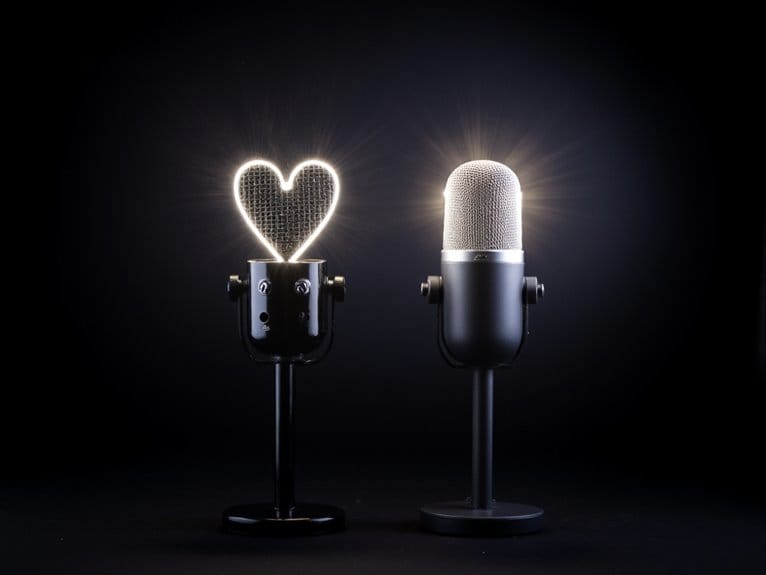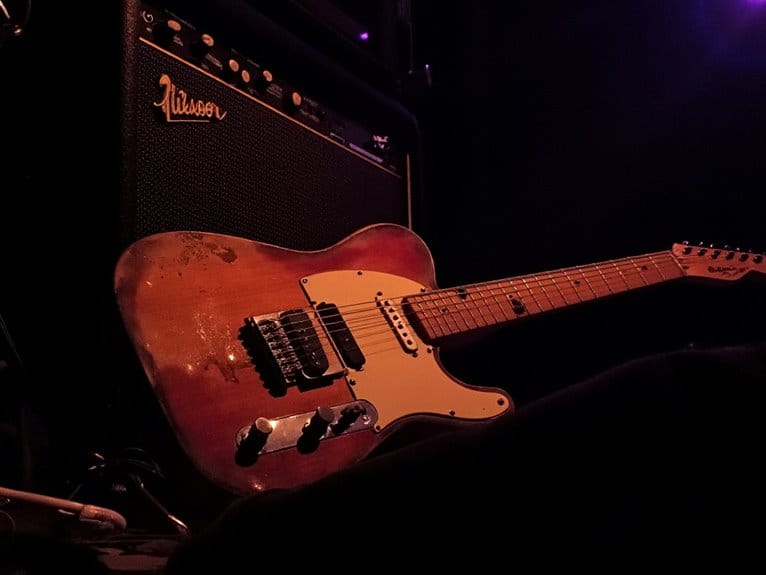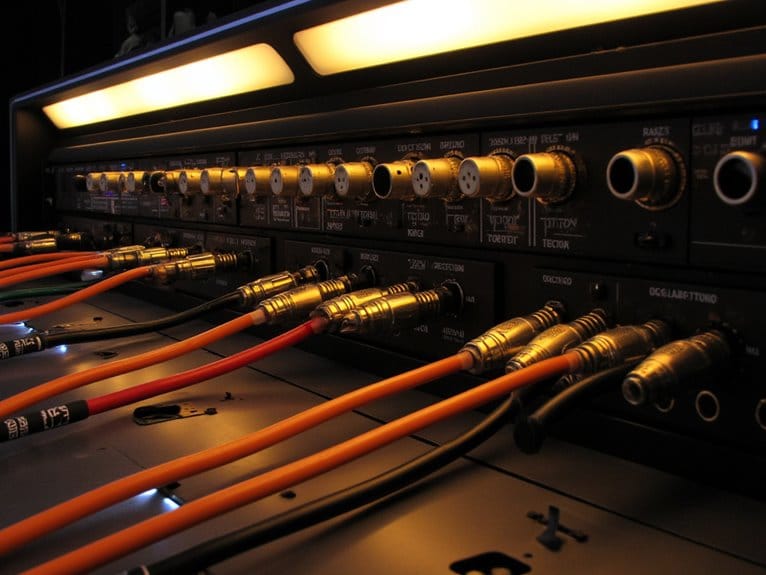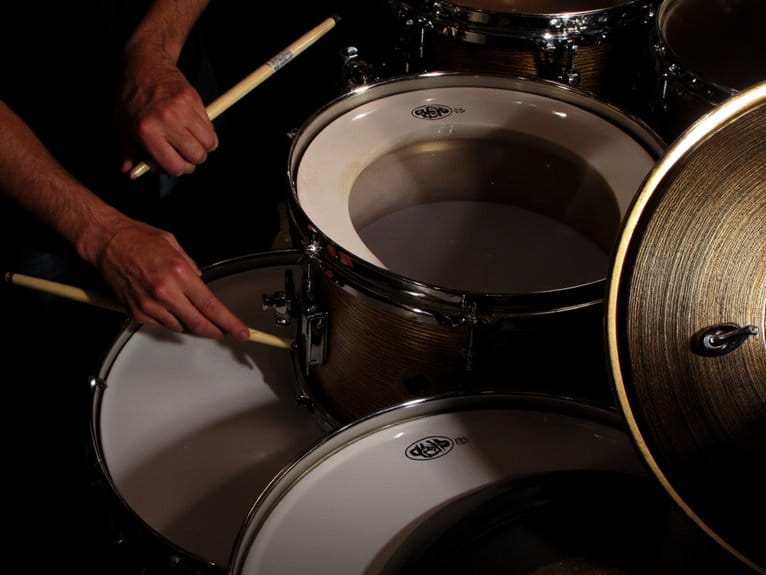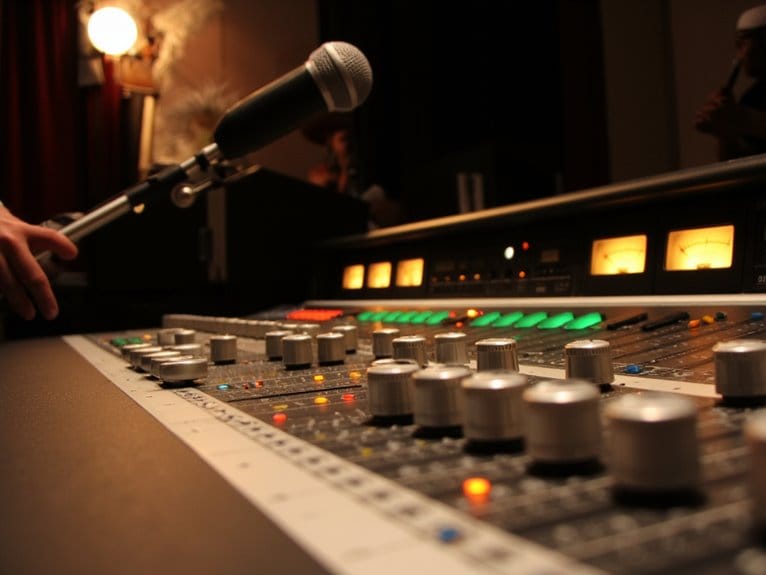Understanding Microphone Pickup Patterns: Cardioid Vs Omnidirectional
Cardioid microphones capture sound primarily from the front in a heart-shaped pattern, effectively rejecting background noise from the sides and rear, making them ideal for vocals, podcasts, and instrument isolation. Omnidirectional mics record equally from all directions in a 360-degree pattern, preserving natural ambiance and spatial characteristics perfect for ensemble recordings and environmental soundscapes. Your choice depends on whether you need focused isolation or complete acoustic capture, and understanding these technical differences will help you optimize your specific recording scenarios.
We are supported by our audience. When you purchase through links on our site, we may earn an affiliate commission, at no extra cost for you. Learn more.
Notable Insights
- Cardioid microphones capture sound primarily from the front in a heart-shaped pattern, effectively rejecting background noise from sides and rear.
- Omnidirectional microphones capture sound equally from all directions in a 360-degree circular pattern, preserving natural spatial characteristics and ambiance.
- Cardioid mics excel at isolating individual sound sources, making them ideal for vocals, interviews, podcasts, and live performance applications.
- Omnidirectional mics provide superior signal clarity and stable frequency response, perfect for ensemble recordings, group interviews, and acoustic environments.
- Cardioids offer better feedback control and noise rejection, while omnidirectional mics capture more natural soundscapes but require careful environmental management.
What Are Microphone Pickup Patterns and Why Do They Matter?
When I first started working with microphones, I’ll admit I didn’t fully grasp why pickup patterns mattered so much.
But after years of dealing with feedback issues and muddy recordings, I’ve learned that understanding these directional characteristics can make or break your audio quality.
Pickup patterns, also called polar patterns, primarily determine how your microphone responds to sounds coming from different directions relative to the capsule, showing which angles capture sound clearly and which reject it entirely.
These patterns directly influence your microphone applications, whether you’re podcasting, recording music, or capturing field audio, and they’re absolutely essential for managing sound quality in various recording environments where background noise, feedback control, and ambient sound capture can dramatically affect your final results. Visualizations are often used to illustrate pickup patterns and sound capture areas, making it easier to understand which zones around the microphone will actively capture or reject audio signals.
The choice of pickup pattern becomes especially critical when dealing with the proximity effect, where directional microphones like cardioids and figure-8 patterns experience increased bass response as sound sources move closer to the microphone.
Professional microphones like the Shure SM58 utilize cardioid patterns specifically to focus on the vocalist while minimizing background noise interference during live performances. Dynamic microphones are particularly valued for their durability and ability to withstand heavy use while maintaining consistent pickup pattern performance across various environmental conditions.
How Omnidirectional Microphones Capture Sound From Every Direction
Although most microphones pick up sound with some directional bias, omnidirectional mics break that rule entirely by capturing audio equally from every angle around their diaphragm, creating what I’d describe as a complete 360-degree sound picture of your recording environment.
The diaphragm responds to pressure variations uniformly, converting acoustic energy into electrical signals through capacitance modulation between the diaphragm and backplate, which preserves spatial characteristics without favoring any particular direction. This design typically provides satisfactory recordings at distances up to around 2 feet from the sound source.
These microphones excel at capturing ambiance because they don’t reject sounds from any side, making them perfect for omnidirectional soundscapes where room acoustics matter. Unlike directional microphones, omnidirectional mics are free from proximity effect, which allows for more natural sound reproduction regardless of distance from the source.
Professional omnidirectional models can achieve impressive signal-to-noise ratios ranging from 70 dB to 120 dB, ensuring clear separation from background noise for high-quality recordings. For optimal performance with wind instruments like flute, positioning these microphones 6-12 inches from the embouchure hole captures the full tonal range while maintaining natural sound characteristics.
- Natural ensemble recordings where multiple instruments contribute to the overall texture
- Conference settings requiring pickup of speakers from various positions
- Home studio applications for acoustic guitars with desired room character
The Science Behind Cardioid Microphone Directional Sensitivity
You’ll find that cardioid microphones achieve their heart-shaped pickup pattern through a pressure gradient transducer design, which cleverly uses both the front diaphragm and a rear port to create destructive interference that cancels unwanted sounds from behind.
What’s particularly fascinating is how these microphones don’t maintain perfectly consistent directionality across all frequencies, as their frequency-dependent directional response means they’re typically most directional in the midrange frequencies where human speech sits, while becoming slightly less focused at very low and very high frequencies.
I’ve noticed that understanding these two core principles, the pressure gradient mechanism and frequency-dependent behavior, helps explain why cardioid mics perform so reliably in most recording situations yet occasionally surprise you with unexpected pickup characteristics at the frequency extremes. This directional advantage makes them exceptionally effective at rejecting background noise compared to omnidirectional microphones, which is why they’ve become the go-to choice for most vocal and instrument recording applications. The enhanced gain-before-feedback capability of cardioid microphones makes them particularly valuable in live performance environments where feedback control is critical. When selecting a cardioid microphone, ensure it covers the full frequency response range of 20 Hz to 20 kHz for professional sound quality. Professional-grade cardioid microphones often feature exceptionally low self-noise levels, with some studio models achieving as little as 7 dB for pristine recording quality.
Pressure Gradient Transducer Design
Since I’ve spent countless hours analyzing microphone capsule designs in my studio, I can tell you that the magic behind cardioid microphones lies in their pressure gradient transducer construction, which cleverly exploits the physics of sound pressure differences to create directional sensitivity.
Unlike omnidirectional mics that respond to absolute pressure, these designs expose both sides of the diaphragm to sound wave interaction, creating a diaphragm response based on pressure differentials rather than total pressure.
The housing contains strategically placed openings that allow controlled rear access, while damping materials attenuate unwanted signals. This design creates a notable proximity effect that enhances bass response when sound sources are positioned close to the microphone. The smooth off-axis curves prevent coloration effects during recording, which is crucial for maintaining audio quality when sound arrives from different angles.
Here’s how engineers achieve different patterns:
- Pure pressure-gradient: Creates figure-of-eight pickup with equal front/rear sensitivity
- Cardioid combination: Blends pressure and pressure-gradient effects through partial rear attenuation
- Electrical coupling: Allows real-time pattern adjustment in condenser microphones
Frequency-Dependent Directional Response
The elegant engineering behind pressure gradient transducers becomes considerably more complex when you examine how cardioid microphones actually behave across the frequency spectrum, where their directional characteristics shift dramatically from the textbook heart-shaped pattern depending on the wavelength of incoming sound.
At low frequencies, your cardioid mic fundamentally becomes omnidirectional, losing that precise rear rejection you’re counting on for microphone applications requiring isolation.
Higher frequencies deliver the classic directional performance through improved phase cancellation, while mid-range frequencies fall somewhere between these extremes.
This frequency response variability means your microphone’s polar pattern literally reshapes itself as different frequencies pass through it, creating practical challenges for consistent sound rejection across the full audio spectrum that engineers address through careful acoustic labyrinth design and strategic vent placement. The rear venting must be precisely timed to reach the diaphragm simultaneously for effective sound cancellation at the microphone’s null points.
Understanding these frequency-dependent behaviors helps explain why cardioid microphones excel in live performances where feedback reduction and focused pickup are essential for professional sound quality.
Sound Quality Differences Between Omnidirectional and Cardioid Designs
When comparing sound quality between omnidirectional and cardioid microphone designs, I’ve found that each pattern offers distinct advantages rooted in their fundamental construction differences.
Omnidirectional mics typically deliver superior signal clarity due to their simpler pressure transducer design, which reduces internal complexity and potential failure points. You’ll notice they maintain consistent frequency response across all directions, whereas cardioid mics can suffer from less ideal off-axis performance, particularly in higher frequencies.
The sound distortion characteristics reveal another key difference—omnidirectional designs generally produce cleaner audio with lower distortion levels, especially compared to budget cardioid models.
However, cardioid mics excel at isolating your primary sound source through focused pickup patterns. For professional applications, supercardioid pickup patterns improve focus on desired sound sources while offering enhanced directional control compared to standard cardioid designs.
Most condenser microphones require phantom power to operate their internal preamps, which is typically provided through audio interfaces or professional mixers.
- Omnidirectional mics offer more consistent frequency response and thermal stability
- Cardioid designs provide superior background noise rejection but with increased complexity
- Signal uniformity varies considerably between patterns across different frequency ranges
Environmental Noise Handling in Different Pickup Patterns
When you’re recording in real-world environments, you’ll quickly discover that cardioid microphones excel at rejecting unwanted noise from their sides and rear, effectively reducing background interference by approximately 20 dB compared to their omnidirectional counterparts.
I’ve found that omnidirectional mics, while capturing sound uniformly from all directions, tend to pick up considerably more ambient noise since they’re equally sensitive to sounds coming from every angle around the capsule.
This fundamental difference means you’ll need to choose your pickup pattern based on whether you want focused isolation from environmental distractions or thorough capture of your surrounding acoustic space.
For podcasting applications specifically, cardioid pickup patterns are strongly recommended because they provide superior background noise rejection, making them ideal for untreated rooms and noisy environments where consistent audio quality is essential.
Additionally, supercardioid patterns provide even narrower pickup angles than standard cardioid microphones, though they require more precise positioning to maintain optimal sound capture.
Cardioid Noise Rejection
Background noise becomes the enemy of clear recordings, and cardioid microphones excel at fighting this battle through their strategically designed pickup pattern that captures sound primarily from the front while actively rejecting audio from the sides and rear.
These cardioid mic advantages make them incredibly effective in less-than-perfect recording environments, where you can’t control every sound source around you.
The directional sound isolation capabilities work through phase cancellation and sensitivity patterns that dramatically drop off behind the microphone, effectively minimizing ambient environmental noise like air conditioning, room reflections, and unwanted chatter.
Key cardioid noise rejection benefits include:
- Enhanced signal-to-noise ratio by focusing exclusively on your intended sound source
- Reduced post-production editing since background interference gets eliminated during recording
- Superior performance in untreated spaces compared to omnidirectional alternatives
Omnidirectional Ambient Capture
While cardioid microphones excel at rejecting unwanted noise, omnidirectional microphones take the complete opposite approach by embracing every sound in their environment, capturing audio equally from all 360 degrees around the capsule.
This all-encompassing pickup pattern makes them perfect for recording ambient soundscapes, orchestral performances, and group conversations where you want natural spatial context preserved.
You’ll find omnidirectional mics don’t suffer from proximity effect, delivering more natural sound reproduction without bass buildup when sources move closer.
However, they can’t discriminate between desired audio and background noise, making room acoustics essential for quality results.
When you’re creating immersive experiences or documentary work where environmental authenticity matters more than isolation, omnidirectional microphones capture the complete acoustic picture with remarkable spatial accuracy.
On a final note
You’ve now got the foundation to make informed microphone decisions, whether you’re recording vocals in your home studio, capturing ambient sounds outdoors, or managing multiple audio sources simultaneously. Remember, there’s no universally “best” pickup pattern—your specific environment, sound sources, and recording goals should drive your choice. I’d recommend experimenting with both cardioid and omnidirectional microphones in your typical recording scenarios to discover what works best for your unique needs.

